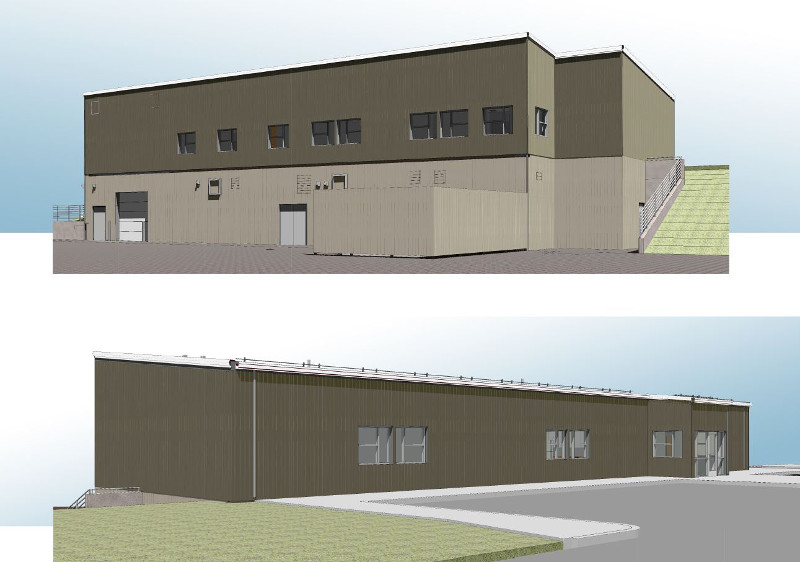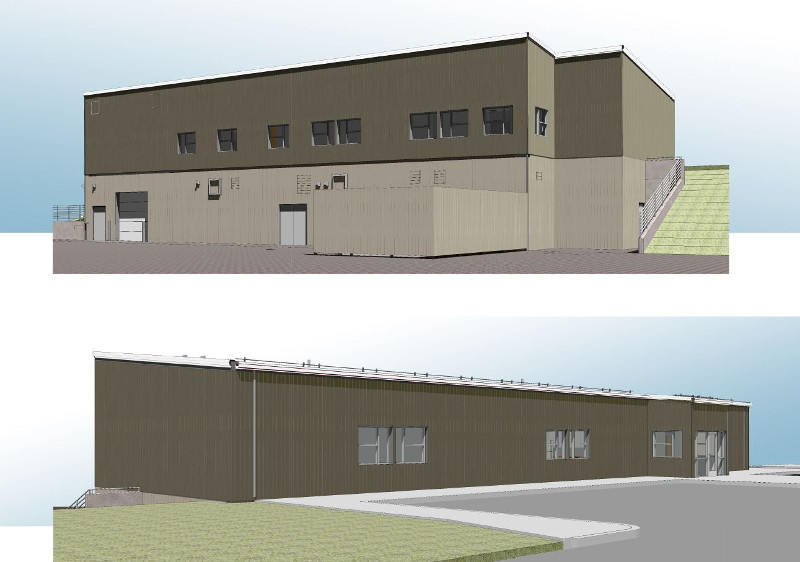Aquaculture Facility Aims to Make Inland Marine Fish Farming a Reality
To help fulfill of the Aquaculture Research Institute’s goals, the new facility will study ways to make the farming of saltwater fish possible away from the ocean.
According to the United Nations Food and Agriculture Organization (FAO), the world consumed 125 million metric tons of fish in 2011. Roughly 62 million metric tons of these fish originated from aquaculture. By 2030, aquaculture must double to meet expected demand due to population growth and rising incomes.
At the University of Idaho’s Aquaculture Research Institute, a unique new facility is nearing completion in Moscow — one that can help support the growing demand for fish-based protein, build Idaho’s aquaculture industry and help make saltwater fish production a reality hundreds of miles inland.
“The level at which we’re harvesting wild-caught fish is not sustainable,” said Scott Williams, research facility manager for U of I’s Aquaculture Research Institute. “It’s peaked, and it isn’t going to grow further. As the human population increases, demand for seafood can only be met by producing more fish through farming. The future of aquaculture growth is growing marine organisms, like salmon, inland in terrestrial environments.”

U of I is working with industry partners and scientists to meet that demand.
Construction on the new facility, which replaces an older building, began in April 2017 and will be completed in summer 2018. It will be one of the only facilities in the West capable of conducting research on genetics, nutrition, selective breeding, physiology, fish health and endangered species on freshwater and marine fish species.
“We provide a place for researchers, wherever they come from, to do work here,” Williams said. “It’s a facility that enables collaborative and cutting-edge research in a unique terrestrial setting.”
Idaho is the U.S.’s largest producer of commercially farmed trout. The new facility will expand that technology to allow for the farming of saltwater species.
“If freshwater fish can be successfully farmed in a terrestrial setting like Idaho, there’s no reason that salmon and other marine fish have to be grown in coastal states,” Williams said. “This facility will further support a huge sector of Idaho’s animal agriculture economy — and help us develop the tools and knowledge to grow even larger.”
Construction of the facility was paid for through $2 million in state funding. The remaining costs, up to $400,000, will be paid through the Vandal Strategic Loan Fund, a program that enables university entities to make key purchases or investments in order to move programs or initiatives forward.
About the Aquaculture Research Institute
The Aquaculture Research Institute was created in 1988 and supports interdisciplinary research into food production and fisheries enhancement across the state. Projects involve researchers from the colleges of Science, Natural Resources and Agricultural and Life Sciences. Research conducted at the institute’s two Moscow facilities complement the university’s Hagerman Fish Culture Experiment Station located in Hagerman.
Building on a tradition of partnership
A central tenet of the Aquaculture Research Institute is collaborating with government and industry partners.
One of these partnerships is a project between U of I and the Kootenai Tribe studying burbot production. The tribe built a hatchery to mitigate the effects of a dam built along the Kootenai River in Montana. The dam altered water flows, negatively affecting the reproduction of burbot and reducing burbot populations.
To help solve the issue, the tribe turned to ARI to conduct research on burbot production in captivity. The research project, now in its 10th year, provided the tribe with techniques and best practices to commercially produce burbot for release to help restore wild stocks.
“Overcoming the challenges to increase aquaculture production in environmentally friendly and sustainable manner requires scientific advances in fish feeds, selective breeding, farming systems and fish health management, woven together using a holistic approach.” –Ronald W. Hardy
Other projects involve multiple varieties of trout, as well as sturgeon, Chinook salmon and other species of fish. Some of these current projects include:
- The exploration of strategies to maintain healthful levels of omega-3 fatty acids in farmed fish fillets.
- The formulation of more efficient feeds, which can reduce nitrogen and phosphorus loss in fish and ensure a cleaner environment.
- The development of a vaccine to protect salmonids against coldwater disease, a bacterial disorder that has caused significant losses to the aquaculture industry in Idaho and the rest of the world.
- Selective breeding programs for the regional trout industry, allowing producers to incorporate improved strains into their broodstock populations.
- The identification of genetic markers associated with high growth performance when fed low or zero fishmeal feeds. These markers can accelerate the genetic improvement of other farmed fish species.
With an expanded capacity to conduct research, institute Director Ron Hardy is looking for new external partnerships with industry, government, tribal communities and other organizations.
“The U.S. imports over 90 percent of the seafood we consume. The focus of ARI is to increase domestic production of fish to ensure safe and healthful products are available to U.S. consumers,” Hardy said. “Overcoming the challenges to increase aquaculture production in environmentally friendly and sustainable manner requires scientific advances in fish feeds, selective breeding, farming systems and fish health management, woven together using a holistic approach.”
A unique draw for students and researchers
The Aquaculture Research Institute hosts students from Idaho, across the U.S. and globally, including Asia, Europe and South America. The facility expansion allows U of I to grow that educational experience.
The new building will house administrators, visiting faculty and graduate students. It also will include a small conference room for face-to-face instruction, remote learning and teleconferencing for lectures and meetings.
“We provide a place for researchers, wherever they come from, to do work here. It’s a facility that enables collaborative and cutting-edge research in a unique terrestrial setting.” – Scott Williams
The biggest draw, however, will be the facility’s many tanks, incubators, chillers, pumps, blowers, filters and other equipment required for aquaculture research.
“Students from countries that have growing populations and a growing dependency on aquaculture-sourced protein would be very interested in studying here,” Williams said. “This is especially the case for those in Asian countries, where more aquaculture is needed to make up for the overfishing of wild-caught organisms.”
To learn more about ARI, potential partnerships, or studying aquaculture at the University of Idaho, please contact Ron Hardy at rhardy@uidaho.edu or at 208-837-9096, ext. 1105.
Article by Phillip Bogdan, Office of Research and Economic Development
Published on March 26, 2018







